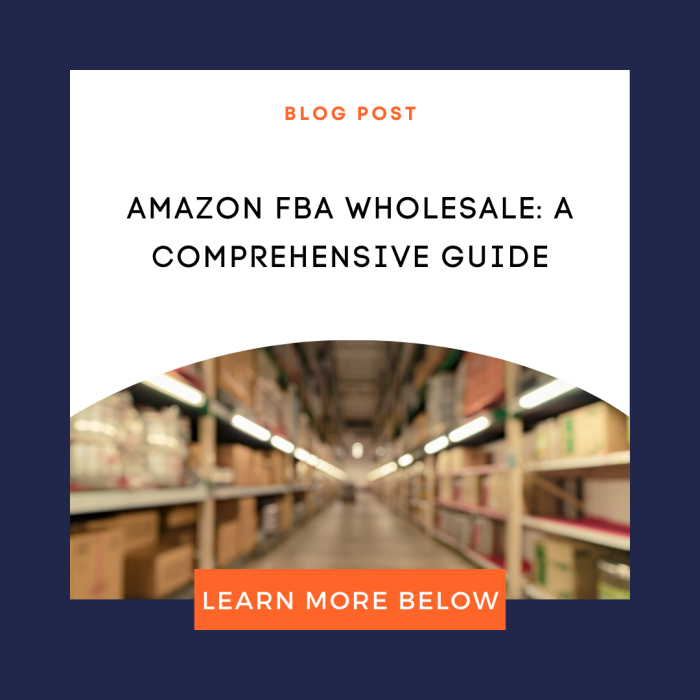In the ever-evolving world of e-commerce, Amazon has consistently been a dominant player. Entrepreneurs and businesses are constantly seeking innovative ways to tap into the vast potential of this retail giant. One such avenue is Amazon FBA (Fulfilment by Amazon) Wholesale, a business model that has gained substantial popularity in recent years. In this blog post, we will explain what Wholesale Amazon FBA is and provide an overview of how the process works.
What is Wholesale Amazon FBA?
Wholesale Amazon FBA is a business model that involves purchasing products in bulk from authorised suppliers or distributors and then selling those products on Amazon’s platform. FBA, or Fulfilment by Amazon, is a service offered by Amazon where they handle storing and shipping your products. This allows sellers to focus on sourcing their products while Amazon takes care of the logistics.
The Wholesale Amazon FBA Process
1. Product Sourcing
The first step in the Wholesale Amazon FBA process is to find products to sell. But how do you do this? This is where softwares like Sourcio really shine. Sourcio helps you to make informed data-based decisions. Invaluable product data is at your fingertips with the help of Sourcio.
To learn more about how Sourcio can help you to source products check out our video here.
So you’ve found an item which is selling well and has the potential to be profitable. Now it is time to find a wholesaler you can buy the product from at a profitable price. It’s essential to establish relationships with reputable suppliers who can provide a consistent supply of quality products.
2. Amazon Seller Account
To start selling on Amazon, you’ll need to create an Amazon Seller account. There are two main types of seller accounts: Individual and Professional. Most Wholesale Amazon FBA sellers opt for a Professional account because it offers more features and the ability to list unlimited products. We would definitely advise opening a Professional account if you are interested in building your own business.
Feeling unsure of how to set up your own account? Don’t worry, we have a video which breaks down the process for you. Watch it here.
3. Product Listing
Once you’ve sourced your products and set up your Amazon Seller account, it’s time to list your products on Amazon. With Amazon FBA you don’t need to worry about creating listings. Instead you can jump onto pre-existing listings. this saves you countless hours of work as your business grows and you list more and more products.
4. Shipping to Amazon Fulfilment Centres
With your products listed, you’ll need to prepare and ship them to Amazon’s fulfilment centres. Amazon will provide specific guidelines on how to label and package your products to ensure they can be processed efficiently.
Our video here explains how this process works. Organising your shipments only takes a few minutes to complete!
5. Amazon FBA Handles Storage and Shipping
Once your products are received at Amazon’s fulfilment centres, Amazon take care of storage, packaging, and shipping to customers. This is one of the key advantages of using FBA, as it eliminates the need for you to handle order fulfilment and customer service directly. This means you can focus on sourcing new best selling products and growing your business.
6. Customer Orders and Support
As customer orders come in, Amazon picks, packs, and ships the products on your behalf. They also handle customer inquiries and returns, making the process relatively hands-off for the seller.
Then all you need to do is repeat this process. You find profitable products, send them into Amazon and Amazon then deal with the rest for you.
Advantages of Wholesale Amazon FBA
- Prime Eligibility: Products fulfilled by Amazon are often eligible for Prime two-day shipping, which can attract more customers.
- Scalability: You can scale your business easily by adding more products or expanding into different niches.
- Fulfilment Efficiency: FBA takes care of logistics, allowing you to focus on growing your business.
- Customer Trust: Amazon’s reputation for reliable service can boost customer trust in your products. With millions of people buying from Amazon regularly you can use Amazon’s popularity and positive brand association to your advantage.
Challenges of Wholesale Amazon FBA
Below we have included the main challenges associated with Wholesale Amazon FBA and how Sourcio helps you to overcome these potential issues.
- Competition: Selling on Amazon can be highly competitive, and standing out requires competitive pricing. With the help of Sourcio you can calculate the price you can sell a product for whilst still being profitable.
- Fees: Amazon charges fees for using their FBA service, which can eat into your profit margins. However, if you are using Sourcio the Sourcio chrome extension will already have factored this into your ROI, with Sourcio automatically displaying all the necessary fees. This way you can ensure you invest in products which will be profitable.
- Inventory Management: Managing inventory levels and avoiding stock outs or overstocking can be challenging. But with the help of Sourcio’s estimated monthly sales feature you can see the estimated sales for a product. As well as Sourcio’s Seller Stock Data feature, allowing you to see how much stock other sellers have and how this may influence your sales.
In conclusion, Wholesale Amazon FBA is a lucrative business model that allows entrepreneurs to tap into Amazon’s vast customer base while outsourcing the logistics of order fulfilment. However, it requires careful product sourcing and ongoing monitoring of your business to be successful. By understanding the process and its challenges, you can make informed decisions and work towards building a profitable Amazon FBA business.

JOIN SOURCIO NOW


Leave a Reply